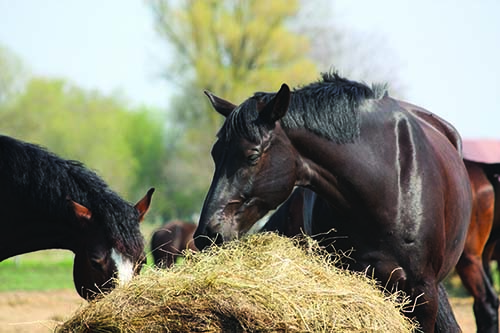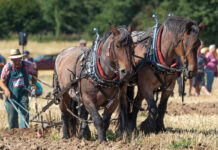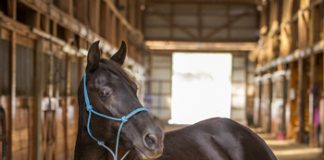I pulled up to a large barn and there was Hans, a large draft-cross gelding, milling sadly around a hay pile. As I watched, he took a bite of hay but seemed unable to draw it into his mouth. He gummed it for about 10 seconds, then it all fell back on to the ground in a wet mass just as his owner had described. Cathy was teary eyed as she slipped a halter over his head and led over her horse who was suffering from an undiagnosed mystery disease.

I loaded up my tote with a stethoscope, thermometer and a flashlight. To be safe, I put on a pair of heavy-duty exam gloves. I didn’t yet know what was going on with Hans, but horses with chewing and swallowing issues make me nervous. There are a few possible infectious causes, some of which could be dangerous to humans, and I wasn’t taking any chances. I made Cathy glove up, too.
The Mystery Disease Exam
Hans’s vitals were worrying: an elevated heart rate and low body temperature. His mucus membranes were muddy with a very slow capillary refill time, which told me that he was dehydrated and in shock.
The rectal exam revealed rock-hard, mucus-covered manure balls in a flaccid rectum. There was no muscle tone in any of the intestine that I could palpate, and nothing seemed to be moving.
The tail and anal tone were very poor, and Hans’ triceps, chest and hamstring muscles twitched and jumped randomly. Another strange sign, he was also walking as though he were drunk.
We offered Hans some water. The big gelding shoved his muzzle deep into the bucket in frustration, then flipped his head back and forth, sloshing water everywhere. It was clear that he was unable to swallow.
I opened his mouth and gently drew his tongue forward, and Hans made no attempt to withdraw it or even move it. His tongue was limp in my hand and hung from the side of his mouth when I let it go. His jaw tone was also very poor, and drool spilled from his lower lip.
Cathy watched me expectantly, but my mind was racing, trying to come up with a list of diseases that would explain all of Hans’s clinical signs. I’ve learned the hard way to not talk too much until I’ve had a chance to formulate some ideas, otherwise I tend to contradict myself and confuse the owner.
Thinking Through the Mystery
Could this be trauma? He was walking very strangely. Maybe he’d collided with another horse on the ranch, except he showed no signs of a concussion, and I’d seen plenty of those when I was a rodeo vet.
EPM? We didn’t really have many cases high in the Colorado Rockies, and there was no significant travel history. A virus that affected the brain? Supposedly he was fully vaccinated.
While I was thinking through possible differential diagnoses, I clipped Hans’s jugular vein to place an IV catheter, and connect two large bags of fluids. I didn’t know what was going on with this mystery disease, but I could at least treat his dehydration.
I also passed a stomach tube and cautiously delivered a small amount of electrolyte water after I was certain that he wasn’t refluxing. Once he was hydrated, I blasted a high dose of steroids through his catheter.
Then a horrible idea hit me. Could this possibly be rabies? There had been a recent case in a mule in an adjoining county, but he’d been vaccinated, hadn’t he?
“Cathy, he had the rabies vaccine this year, right?”
She frowned. “You know, I don’t think he did. The vet said it wasn’t necessary, because we don’t see rabies up here.”
Hans’ vitals were worrying: an elevated heart rate and low body temperature. His mucus membranes were muddy with a very slow capillary refill time, which told me that he was dehydrated and in shock.
Considering More Causes of a Mystery Disease
My heart pounded. Now I had to put rabies on the list, and the more I thought about it, the more frightened I felt. I pictured the thin trickle of saliva, the inability to drink, the muscle tremors. So many of Hans’ signs of his mystery disease matched.
My hands shook as I added calcium gluconate and dextrose to the fluids, while Hans nuzzled my arm gently. Could a rabies patient be this bright and alert?
Cathy stroked Hans’s neck. “Moldy grain? Something in the water?”
I shook my head.
“No, surely not. And there aren’t any toxic weeds in his paddock. He’s getting grass hay, right?”
She nodded.
“In fact, they put a huge round bale in the feeder last week.”
I frowned. A huge round bale, a horse not walking well, muscle tremors, poor tongue and tail tone. Something was trying to formulate in my brain, and I walked towards my car in frustration, trying to put it all together. What was the connection creating this mystery disease?
Lightbulb Moment Reveals the Mystery Disease
Then it hit me. And it was not an option that I wanted on my list.
Botulism—probably from an animal carcass baled up in the hay. Large round or square bales are the perfect anaerobic environment for Clostridium bacteria to generate botulism spores and their deadly toxin; then the poor, unsuspecting horse eats the contaminated hay.
An icy hand gripped my chest, and I frantically started scrolling through the vet manuals on my phone. Hans had every single sign. I looked back at Hans and Cathy standing together, and my heart sank.
A quick call to the veterinary university confirmed my suspicions, although rabies was also still possible. Soon Cathy and I were ushering Hans onto her trailer, and they headed to the referral hospital.
The news was grim. Botulism was indeed the top suspect of the mystery illness, and the antitoxin was several thousand dollars. Without it, Hans had virtually no chance of recovery, and even with it, his odds of survival were only about 20 percent.
Cathy didn’t hesitate, and soon Hans was receiving the potentially lifesaving treatment. But would it be enough to save him?
Read the conclusion of this story here.
This Vet Adventures column about identifying a mystery disease appeared in the May 2021 issue of Horse Illustrated magazine. Click here to subscribe!





